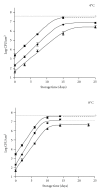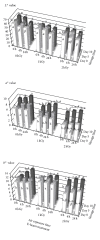Use of e-beam for shelf-life extension and sanitizing of marinated pork loin
- PMID: 23227053
- PMCID: PMC3512307
- DOI: 10.1155/2012/962846
Use of e-beam for shelf-life extension and sanitizing of marinated pork loin
Abstract
The effectiveness of E-beam radiation to extend the shelf-life of marinated pork loin slices stored at 4 and 8°C (temperature abuse) has been studied. The shelf-life was extended from 7 to 16 and >20 days after the application of 1 and 2 kGy, respectively. In the event of a temperature abuse occuring during the product distribution (e.g., increase to 8°C), the shelf-life would be extended from 5 to 10 and 16 days, respectively, when applying the doses mentioned previously. From a public health point of view, the irradiation of marinated pork loin may be marketable for a longer period of time of up to two weeks, and guarantees a practically Salmonella and Listeria-free product. Minor changes are produced by the E-beam treatment in the main sensory and rheological characteristics. The odor was the most affected feature, but the off-odors diminished with increased storage. In any case, testers judged the samples to be adequate for marketing.
Figures



Similar articles
-
Shelf-life extension and sanitation of fresh pork loin by E-beam treatment.J Food Prot. 2012 Dec;75(12):2179-89. doi: 10.4315/0362-028X.JFP-12-217. J Food Prot. 2012. PMID: 23212015
-
Influence of low-energy electron beam irradiation on the quality and shelf-life of vacuum-packaged pork stored under chilled and superchilled conditions.Meat Sci. 2023 Jan;195:109019. doi: 10.1016/j.meatsci.2022.109019. Epub 2022 Oct 28. Meat Sci. 2023. PMID: 36335867
-
Effects of Traditional Sauce Type and Storage Time on Quality Characteristics, Shelf-life and Flavor Compounds of Marinated Pork Cooked by Sous Vide Method.Food Sci Anim Resour. 2019 Jun;39(3):355-370. doi: 10.5851/kosfa.2019.e27. Epub 2019 Jun 30. Food Sci Anim Resour. 2019. PMID: 31304465 Free PMC article.
-
Use of Essential Oils to Increase the Safety and the Quality of Marinated Pork Loin.Foods. 2020 Jul 24;9(8):987. doi: 10.3390/foods9080987. Foods. 2020. PMID: 32722045 Free PMC article.
-
A comparison between E-beam irradiation and high pressure treatment for cold-smoked salmon sanitation: microbiological aspects.Food Microbiol. 2009 Apr;26(2):224-7. doi: 10.1016/j.fm.2008.10.007. Epub 2008 Nov 1. Food Microbiol. 2009. PMID: 19171266
Cited by
-
Meat Irradiation: A Comprehensive Review of Its Impact on Food Quality and Safety.Foods. 2023 Apr 29;12(9):1845. doi: 10.3390/foods12091845. Foods. 2023. PMID: 37174383 Free PMC article. Review.
-
Synthesis and characterization of novel bactericidal Cu/HPMC BNCs using chemical reduction method for food packaging.J Food Sci Technol. 2015 Sep;52(9):5982-8. doi: 10.1007/s13197-014-1615-0. Epub 2014 Nov 22. J Food Sci Technol. 2015. PMID: 26345017 Free PMC article.
-
Ligilactobacillus salivarius MP100 as an Alternative to Metaphylactic Antimicrobials in Swine: The Impact on Production Parameters and Meat Composition.Animals (Basel). 2023 May 16;13(10):1653. doi: 10.3390/ani13101653. Animals (Basel). 2023. PMID: 37238083 Free PMC article.
References
-
- McGee MR, Henry KL, Brooks JC, Ray FK, Morgan JB. Injection of sodium chloride, sodium tripolyphosphate, and sodium lactate improves Warner-Bratzler shear and sensory characteristics of pre-cooked inside round roasts. Meat Science. 2003;64(3):273–277. - PubMed
-
- Prestat C, Jensen J, McKeith FK, Brewer MS. Cooking method and endpoint temperature effects on sensory and color characteristics of pumped pork loin chops. Meat Science. 2002;60(4):395–400. - PubMed
-
- Sheard PR, Tali A. Injection of salt, tripolyphosphate and bicarbonate marinade solutions to improve the yield and tenderness of cooked pork loin. Meat Science. 2004;68(2):305–311. - PubMed
-
- Vote DJ, Platter WJ, Tatum JD, et al. Injection of beef strip loins with solutions containing sodium tripolyphosphate, sodium lactate, and sodium chloride to enhance palatability. Journal of Animal Science. 2000;78(4):952–957. - PubMed
-
- Xiong YL, Kupski DR. Time-dependent marinade absorption and retention, cooking yield, and palatability of chicken filets marinated in various phosphate solutions. Poultry Science. 1999;78(7):1053–1059. - PubMed
LinkOut - more resources
Full Text Sources

